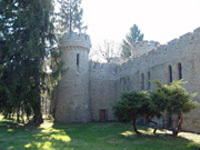
There are places made sacred because of what has happened there, like the Church of the Holy Sepulchre and the Al Aqsa Mosque in Jerusalem. Other places, like the Grotto of Our Lady of Lourdes here at Notre Dame, or Saint Patrick’s Cathedral in New York City, become sacred as thousands of people visit them to pray earnestly and passionately, places, to use T.S. Eliot’s phrase, “where prayer has been valid.”
In any event, as Mary Joe Weaver insists, “sacred space can be created.” Weaver, a professor of religious studies at Indiana University, makes that assertion in her remarkable 2002 book, “Cloister and Community: Life Within a Carmelite Monastery,” which began as an architectural history of the 80-year-old Carmelite monastery in Indianapolis and became a meditation on sacred space by way of an excursion through Carmelite spiritual life.
Among other fortunate developments from Weaver’s research has been her recommendation, and the Carmelite community’s agreement, to make Notre Dame’s archives the repository of the massive historical record of the Carmelite Sisters of Indianapolis.
While Carmelite sisters worldwide trace their origins all the way back to Mount Carmel and the Old Testament prophet Elijah, who humiliated the priests of Baal there, their rebirth in Indianapolis was a peculiarly modern and American occurrence.
Early last century, Emma Seelbach, a beautiful and intellectually gifted young woman from the Kentucky aristocracy, was travelling in Europe and studying opera when she came across the autobiography of one of the great Carmelite saints, Therese of Lisieux, and fell in love with the contemplative life so plainly and vividly described there. She entered the Carmelite monastery in Davenport, Iowa, in 1912, taking the religious name of Sister Theresa of the Trinity.
Sister Theresa was namesake to the great Saint Theresa of Avila, another aristocrat and Carmelite, though a Spanish one, whose medieval hometown with its parapets, turrets and towers so fired the young Kentuckian’s imagination that she persuaded the architects of the Indianapolis monastery she founded in 1929 to evoke them in its design. The massive building which now sits in an unremarkable Midwestern urban neighborhood is not, as Weaver writes, “built on a mountaintop or nestled into some glen of extraordinary beauty. Yet, what might take one’s life away is the consistency of life in this setting: it has supported a community of women dedicated to prayer for [more than] seventy-five years.”
The impressive paper trail left in the wake of those monastic years is now housed at Notre Dame, some 44 linear feet of records in all. It includes files on the history of the monastery, including documentation of the inclusive language psalter the community developed and published in recent years; records of the Carmelites’ religious typesetting business, of the development of their Web site and of their annual interfaith prayer service for peace. There also are chronological files, correspondence, newspaper clippings, books, newsletters and scholarly periodicals, even such historical artifacts as the religious habit worn by the Carmelite sisters before the Second Vatican Council and the bakery equipment they used to make altar breads for Eucharistic liturgies.
“For many years we have been interested in documenting contemplative monasticism in the United States,” said Notre Dame archivist Kevin Cawley. “The records of the Indianapolis Carmelites fit in very well with our other contemplative collections. But they are also very rich in evidence of changes in religious life after Vatican II.”
Historians of religious life will doubtless find these records useful. So, too, should anyone fascinated by the way in which an ordinary place, say 10,048 square feet of downtown Indianapolis, can become holy ground.
_Contact: Kevin Cawley at 574-631-6448 or wcawley@nd.edu_